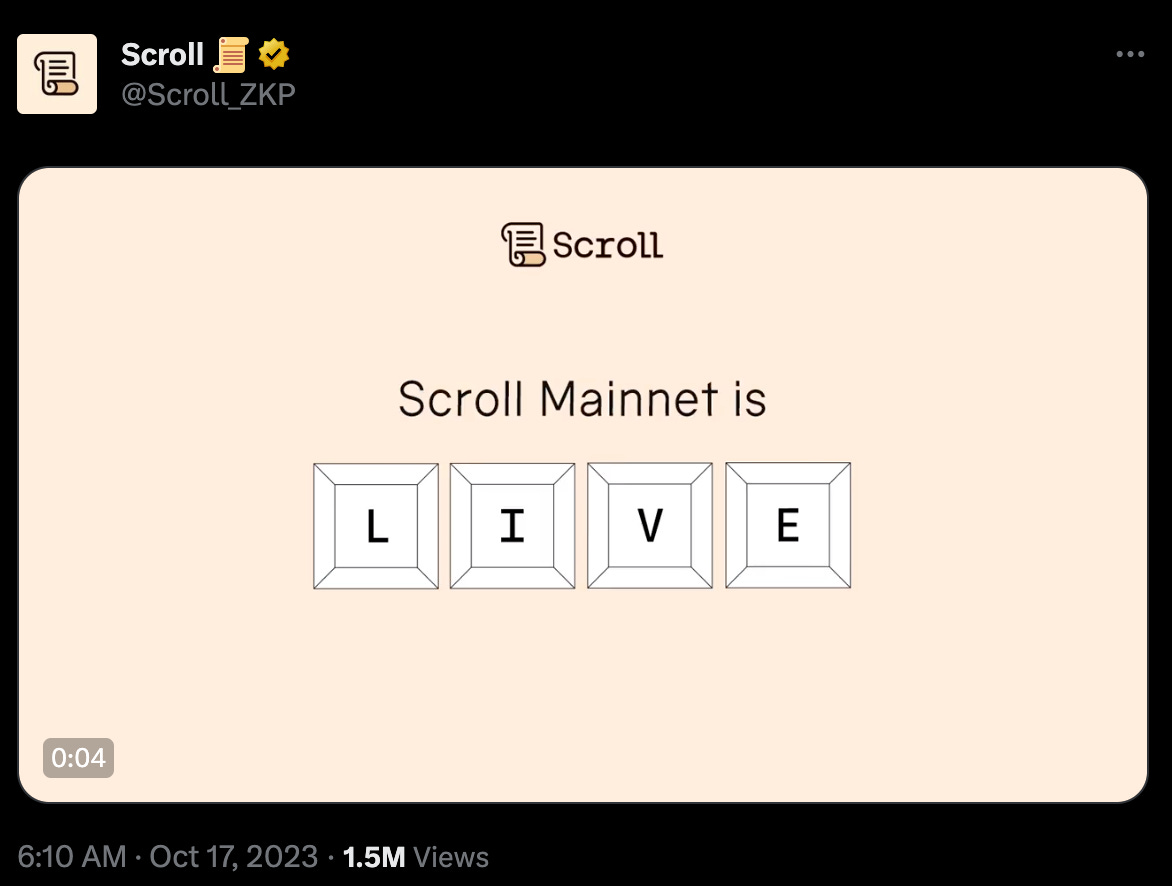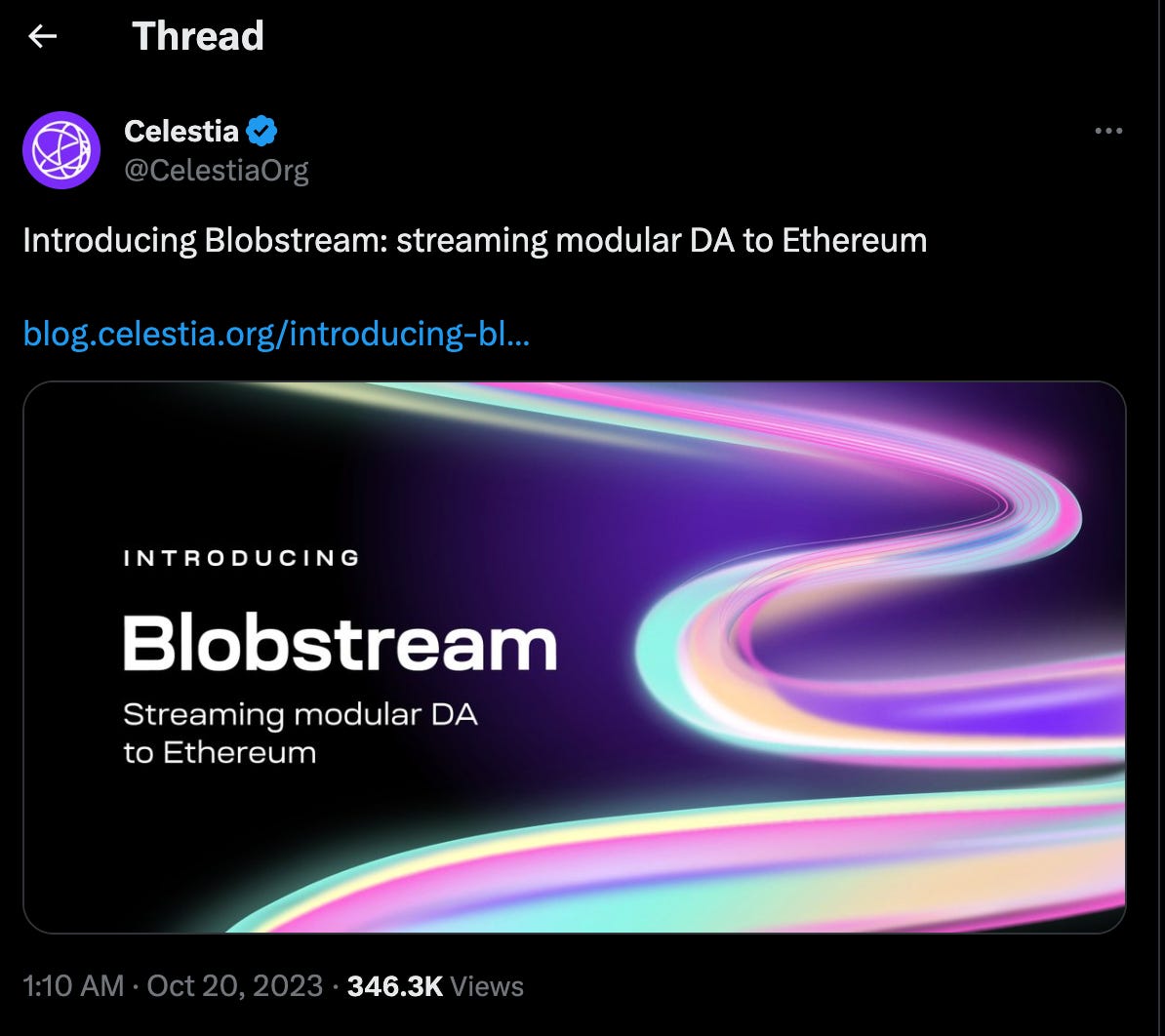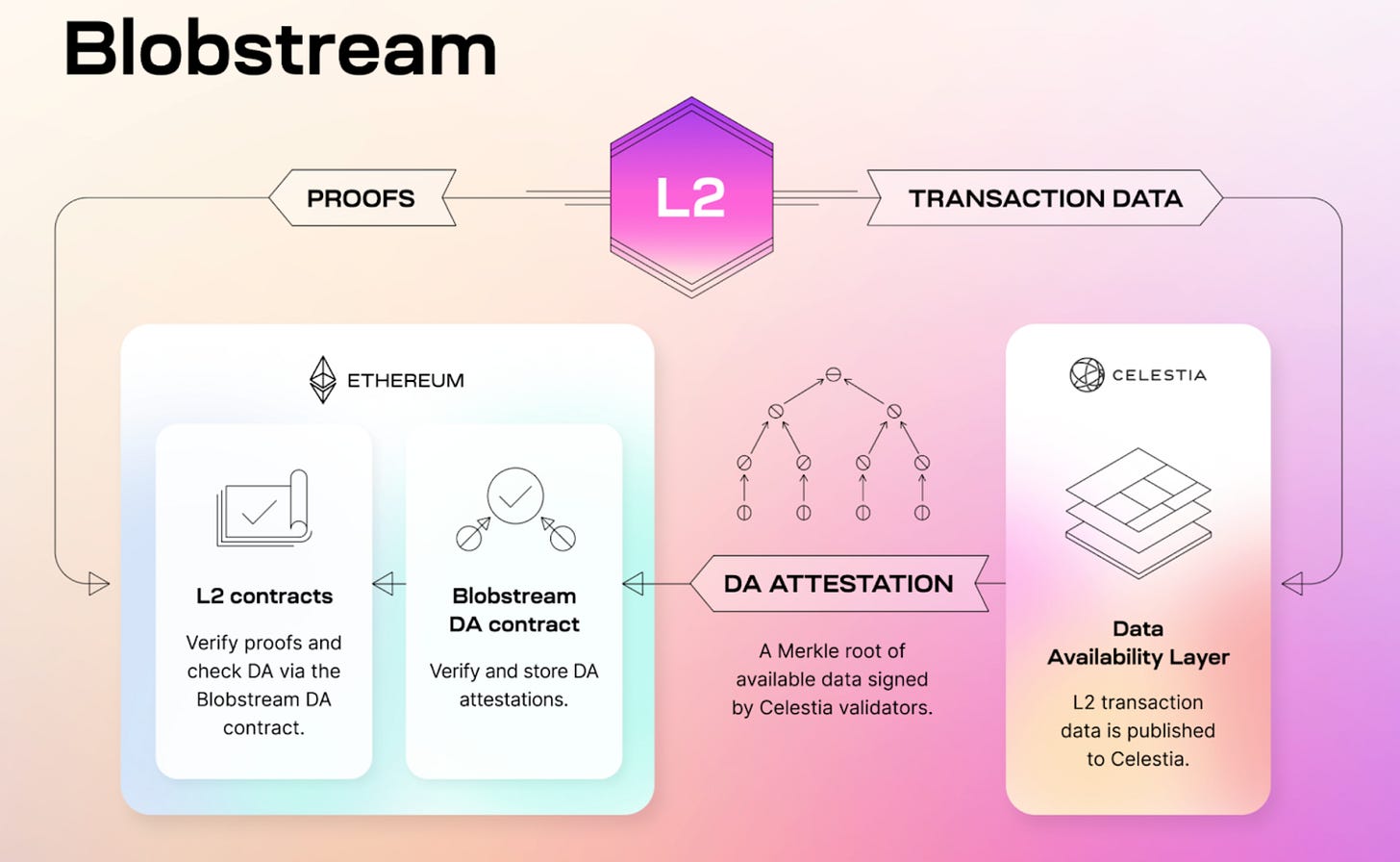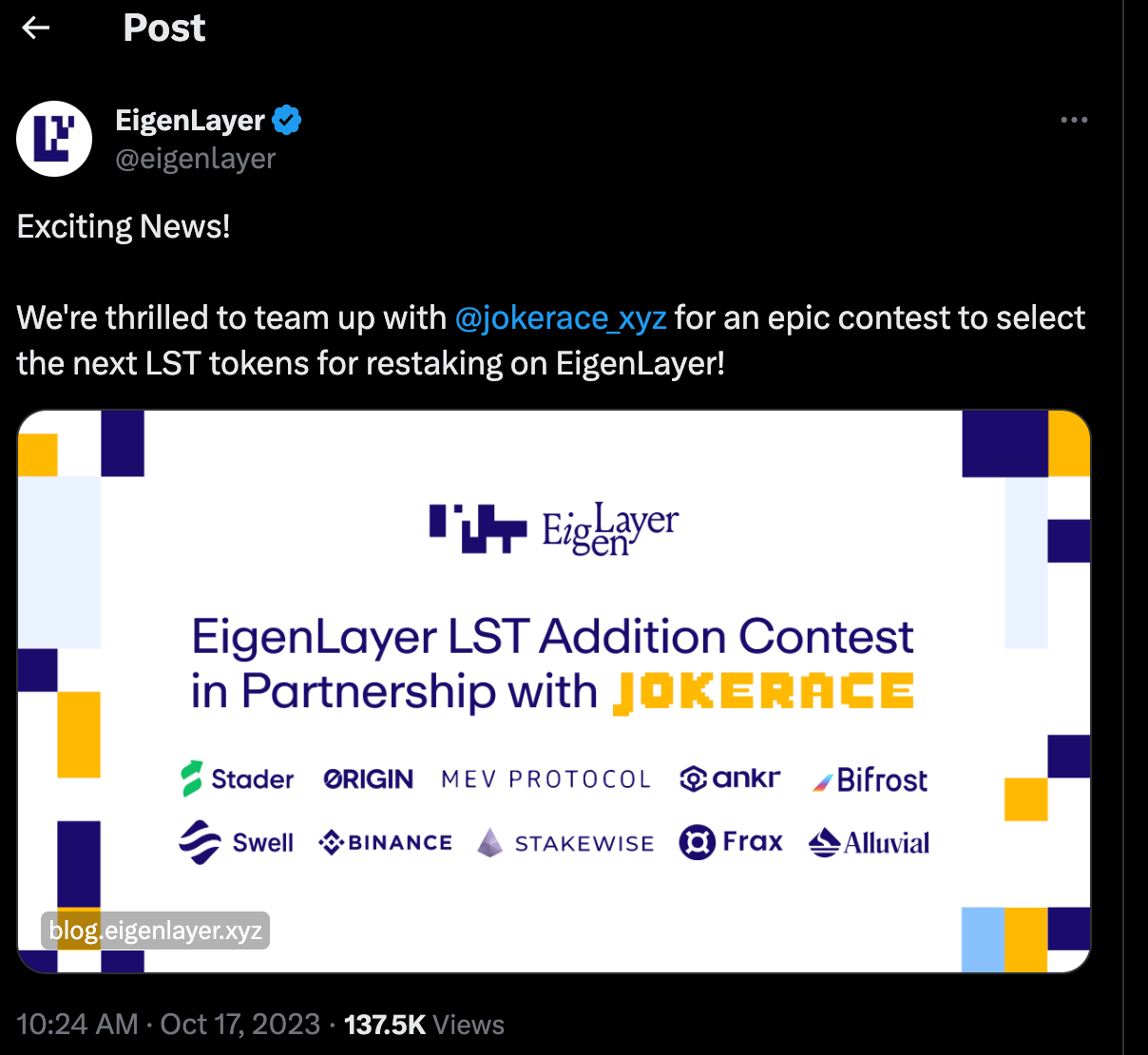Weekly Rollup #37
Another zkEVM hits mainnet | Celestia 🤝 Ethereum | Astria’s Permissionless Deployment | The next LST on Eigen | Modular meets monolithic | Are RaaS providers misaligned? | Week ending October 13th
👋 Welcome to Modular Media! We cover news, updates, educational content, and more within the modular blockchain ecosystem.
Subscribe to get posts sent directly to your email every week, and follow us on Twitter for modular-related updates!
This week’s issue covers:
Scroll Hits Mainnet
Celestia Blobstream: Celestia 🤝 Ethereum
Dusknet: Astria’s Permissionless Deployment
The next LST on Eigen Layer
More News & Announcements
Modular meets monolithic
Are RaaS providers misaligned?
More Education & Discourse
📣 News & Announcements
Scroll Hits Mainnet
Last week, the Ethereum community achieved yet another milestone with the launch of Scroll mainnet. This marks the third significant zkEVM release this year, further shaping the landscape of Ethereum scalability.
As a quick reminder, a zkEVM is a type of rollup. It combines the concepts of zero-knowledge proofs (validity proofs) and the Ethereum Virtual Machine.
validity (zk) proofs: Users submit their transactions on Scroll as they would with any other EVM chain, however, the difference is that a validity proof is generated for each transaction, which is then posted and verified (settled) on the Ethereum Layer 1.
EVM: Scroll is “EVM-equivalent”, meaning that teams are able to take their existing dapps that are currently live on Ethereum, and re-deploy that same contract on Scroll without having to make major changes. In fact, their slogan is “copy, paste, deploy”.
Overall, zkEVMs enable increased speeds and throughput, and reduced transaction costs, all while retaining Ethereum security guarantees.
Testnet Stats
Prior to mainnet launch, the Scroll team had launched three different testnets over a 15-month period.
Who can use Scroll today?
Scroll is completely permissionless today, meaning both developers and users can start interacting with the network. Developers can check out the docs to get started building on the network, while users can start getting themselves ready to use these apps as soon as they go live on the network. To set yourself up, simply:
Add Scroll mainnet to your wallet: Visit Chainlist, search for Scroll, and add.
Bridge $ETH (for gas fees) to Scroll: You can bridge funds to Scroll using either the Scroll’s own native bridge or one of the 3rd party bridges that have integrated the network already, such as Orbiter.
Discover apps: While Scroll has an extensive ecosystem (see image below), most of these apps are still on testnet, meaning you’ll have to wait for a lot of these to migrate over to mainnet. To check out which apps have done so already, you can head to **Scroll’s Explorer page** - just be sure to stay safe and consider revoking access on your wallet after using any app.
Current Stats
Here are some of the numbers Scroll mainnet has reached so far, and keep in mind its only been a week since launch.
TVL:
According to L2Beat, Scroll has reached +$15.5M in TVL so far (ranked 18th):
The total number of distinct addresses on Scroll has now reached +84,500K.
The total number of transactions processed on Scroll so far is +101K.
Congrats to the entire Scroll team for the launch! 🥂
Celestia Blobstream: Celestia 🤝 Ethereum
Last week, Celestia launched Blobstream, paving the way for Celestiums (Celestia + Ethereum) to reach the market.
Celestiums are essentially rollups that settle their proofs on Ethereum, and submit their block data to Celestia, rather than performing both of these duties on Ethereum altogether.
Blobstream, previously known as the “Quantum Gravity Bridge”, is the component that relays the data attestations made by the Celestia validator set, to Ethereum.
data is published to Celestia
Celestia validator set signs off on the data being published
Blobstream is the component that relays these attestations to Ethereum
rollups can query this blobstream contract for the existence of their data
What separates Celestia as a data publication layer is the fact that it is expected to become the first chain to reach mainnet with Data Availability Sampling (DAS). Any user will be able to run a light node to verify for themselves that the correct data is being published on Celestia, without having to download the complete data (as is the case without DAS). Dont trust that the validator set is withholding correct data? Run a light node.
Difference with other data solutions used by rollups
There are typically two ways in which Ethereum rollups handle their data:
Posting data to Ethereum: Most Ethereum rollups do this today, as it is viewed as the most “secure” form, however, this makes up the majority of end-user costs on rollups.
Data Availability Committee: An alternative is using multiple third-party data providers who each sign off on data. While this is a more cost-efficient method, it relies on trusting these third-party providers, who are not slashed on Ethereum for misbehaving.
With Blobstream, rollups teams will be able to access Celestia’s 8MB of blobspace - “8 MB of blobspace roughly translates to between 9,000 and 30,000 ERC-20 transfer transactions per second.” & as we mentioned several times before, the more light nodes, the more Celestia is able to scale its blockspace, without sacrificing security.
Blobstream X
To enhance security guarantees even further, Succinct Labs has developed “Blobstream X”. Earlier we mentioned that validators sign off on the data being published to Celestia - “this occurs in batches of about 400 blocks (once every ~100 minutes)”.
With Blobstream X, a validity proof (zk) is generated for these signatures, which can then be verified onchain (on Ethereum). Celestia has outlined a couple of benefits of Blobstream X:
reduced overhead
request / reponse model
gas savings
zk-proving beyond consensus
Check out the full post to learn all about these benefits, along with everything else about Blobstream. Both Blobstream and Blobstream X are live on testnet today, with mainnet rollout expected over the coming weeks. Builders can get started here.
Dusknet: Astria’s Permissionless Deployment
Astria launched its first permissionless testnet deployment this past week, 🔷
What does this mean?
As mentioned, this is the first time any team will be able to permissionlessly integrate Astria (Dusknet) into their rollup.
If you recall, a sequencer is the component of a rollup that is responsible for user ordering transactions into a block. You can imagine the sort of power that comes from being able to choose the way in which transactions are ordered, such as being able to censor transactions or adjust the transaction order in a way that grants the sequencer with the highest amount of MEV possible. This is why one of the biggest milestones for any existing rollup today is to decentralize their sequencer. That said, most rollups today use a centralized sequencer, meaning the rollup team itself is in charge of ordering transactions within a block.
Astria is building a decentralized shared sequencer that any rollup team can plug into their chain, thereby outsourcing this task to the network of sequencers, the “multiple parties who take turns ordering transactions for each block, eliminating reliance on a single entity and preventing persistent censorship”.
Aside from decentralization, a shared sequencer also offers the following benefits:
rollup composability: “by sharing a sequencer, rollups inherently share a temporal domain (i.e. block timing), allowing for atomic inclusion of transactions for multiple rollups.” Put more simply, it enables transactions between different rollup solutions to happen all at once.
soft commitments: “rollups retrieve the ordered block directly from the shared sequencer to get a soft commitment”. This allows rollups to offer its users faster confirmations, ratehr than having to wait for the block to settle on the L1 (Ethereum).
According to the team, while this version of the testnet will be centralized (hosted by the Astria core team), the next iteration, Dawnnet, is expected to be a decentralized launch. To learn all about Dusknet, you can check out the full post. If you’d like to learn more about Astria, we spoke more about them in a previous newsletter post, here.
The next LST on Eigen Layer
The Eigen Layer community will be able to vote for which LST token they want to see integrated within the Eigen Layer platform next.
As a quick reminder, Eigen Layer is a $ETH restaking protocol. As of today, users were only able to restake either their stETH (Lido staked $ETH), or rETH (Rocket Pool staked $ETH), however, it looks like the community will be able to vote for which LST they want to see integrated into Eigen Layer next. In other words, what liquid staked token do you want to be able to restake on EL next. Options include:
Sometime this week a snapshot date will be announced by the team. Those holding any of these LSTs during the time of the snapshot will be able to vote - “each wallet gets 1 vote for every $USD worth of tokens staked”.
Official voting to follow sometime after, and will take place on the Mantle network (L2).
You can visit the complete post to check out all the details about this vote.
More News & Announcements
Volatillis announces that it will be launching Meliora Chain using Caldera’s RaaS solution. Meliora chain will focus on creating an ecosystem of fixed-income/credit-based apps.
Check out AltLayer’s Q3 stats and milestones achieved. Also, a reminder that AltLayer’s Autonomous Worlds campaign ends this week.
Hyperlane & Celestia are hosting Modular Day on November 13th in Istanbul.
Catalyst is now live on Omni Network’s testnet. This makes the third network integrated within Catalyst’s cross-chain AMM, with the other two being Mantle and Base. Users can start swapping on the network to receive Galxe points, as part of the Catalyst Missions campaign.
Babylon partners with Cubist to offer greater protection for honest BTC restakers.
Eigen Layer announced their Research Fellowship (ERF). Five people will be chosen to work with the Eigen Layer research team on a topic that both parties find interesting.
Celestia’s Genesis Drop (token claiming period) comes to a close. Altogether, there were over 191K claims.
Users can start signing up to become amongst the first validators for Avail, as they prepare for their upcoming testnet launch.
Check out some stats after one month, following Taiko’s latest testne tlaunch
New version of BSafe (multisig wallet) just deployed on Fuel.
Looks like Fiat is launching an NFT collection on Arbitrum.
Pool Together v5 is live on Optimism, featuring a couple new features, including more assets, and more.
Polygon introduces the Protocol Council. Here’s a Space discussion about this.
Manta Pacific announces its transition to adopting Polygon’s CDK (rollup framework).
Cosmos Hub proposal #826 passes, initiating a 5% minimum fee for validators.
Voting for Cosmos Hub proposal #835 has begun: “Transfer unclaimed NTRN airdrop tokens to Cosmos Hub”.
📚 Discourse & Education
Modular meets monolithic
Celestia hosts a discussion with key members of modular and monolithic communities. We highly recommend watching (it’s about an hour long on 1x speed), but in case you don’t get a chance, here are a few takeaways:
Modular and monolithic systems are not all that different. At the end of the day, there’s are full spectrum of solutions and the lines start to blur. For example, Solana could implement data availability sampling and Celestia technically does * some * execution (does this mean it is monolithic?).
Solana maximizes throughput and latency, then optimizes verifiability as best as possible. Celestia maximizes verifiability and throughput, then optimizes latency as best as possible. Eclipse balances verifiability, throughput and latency.
Eclipse is competing for different users than Solana. Eclipse will likely serve users who are already Ethereum aligned and would likely not leave the Ethereum ecosystem. What would they do instead? Potentially build on a different Ethereum rollup with different properties, even though they might like the SVM.
What are other reasons (alignment aside) users might pick Eclipse over Solana? Users often want to leverage ETH and other Ethereum assets (e.g. to serve as their rollup’s primary currency). As an Ethereum rollup, Eclipse enables trust-minimized bridging for these assets, whereas Solana does not. It also does not need to be an either / or decision for users. Solana apps might want to go “multi-chain” and Eclipse is a seamless deployment option.
Is Eclipse “good” for Ethereum, Celestia and Solana? It’s pretty obvious how Eclipse is good for Ethereum and Celestia (using and paying them), but its contributions to Solana are less obvious. That said, open-source innovations to the SVM can be implemented back on Solana if mature and desired by the community. For example, Eclipse is working on ZK proving the SVM, which Solana can leverage.
Everyone is very aligned on building open-source code. Toly would otherwise quit.
Does modular or monolithic “win”? The reality is technology is cyclical. For one period of time modular might be the dominant design, a few years later the pendulum could swing to monolithic, and then a few years after that it could swing back to modular.
Are RaaS providers misaligned?
Norswap expresses concerns with the current state of RaaS. Aside from a potential oversupply of providers, he mostly focuses on vendor lock-in. Let’s dive into it.
Vendor lock-in is not a new problem. In fact, for the tech industry, it’s a very old problem. Companies used to compete using closed IP and legal action, and when they couldn’t, they’d compete using vendor lock-in. Common company practice was to enforce custom integrations, long-term contracts and other arrangements to make sure customers were “stuck” with them.
Over time, market forces have shifted companies away from this strategy - especially in the open-source / cloud infrastructure space. Naturally, companies still want products to be “sticky”, but nowadays this is most often accomplished with opt-in functionality. If customers see value in an extra proprietary feature, they’ll elect to use it, knowing that they will lose such feature if they use the “same” open-source product in a different cloud.
Back to Norswap’s post. Here’s the major question - is this ok in web3?
Don’t get me wrong, there’s a minimum bar for “ability to exit” that RaaS should without a doubt be above. If a RaaS provider has no documentation and doesn’t answer your phone calls when you want to cancel your subscription - clearly unacceptable.
The more interesting discussion is which features (if any) can be kept proprietary in RaaS offerings. Should RaaS providers “commit” to open-sourcing their “whole infrastructure”?
Is it reasonable for them build differentiating functionality for rollup customers?
Does the web3 social layer need to step in?
The Lido debate continues
Hasu discussed his recently proposed three year goals for Lido.
We won’t go into it this week, but here are some interesting reactions to the Space if you want to follow the discourse:
More Discourse & Education
@jon_charb deep dives into rollups (which are now officially REAL) and how security realistically depends on specific confirmation rules ✍️🧠
@kay_phillips_ breaks down the crypto payments landscape ✍️🔥
Bankless discusses Scroll zkEVM mainnet with Sandy and Toghrul from Scroll 🎙️
@mikeneuder outlines the many different entities that compose Ethereum’s consensus layer ✍️🔥
Goombles discusses a hypothetical “why or why not” for moving to an L2 with Sebastian from Paima Studios 🎙️
@CannnGurel explains why the use of ZK proofs in privacy is more limited than their use in scalability 💬
@apriori0x dives into SUAVE, covering geographic decentralization, game warping, strategyproof computing and more ✍️🧠
@0xevevm explains UX advancements, benefits and challenges that ZK proofs bring to digital identity ✍️💎
@francescoweb3 explains what differentiates Scroll from all other zkEVM solutions 💬
@yuxiao_deng explores potential solutions to the Lido centralization controversy 💬💎
@MohamedFFouda breaks down how to scale app rollups, covering ZK state channels and alternative VMs ✍️
Clave explains their approach to key management - Hardware Signer 💬
Bell Curve discusses general and app-specific order flow actions with Xin from Uniswap 🎙️
Zero Knowledge Podcast discusses Multi-Party Computation (MPC) witb Nigel from Zama 🎙️
Risc Zero explains how ZK coprocessors play a part in scaling EVMs 💬
Four Pillars breaks down Argus and how games are built using their World Engine 💬
@nero_eth summarizes findings from simulating a post MEV-Burn world ✍️
Diva explains how Distributed Validator Technology (DVT) prevents slashing 💬
@zerokn0wledge_ walks through Manta Pacific’s architectural journey to become a Polygon CDk chain 💬
@ayyyeandy explains Dymension and how they use IBC to connect RollApps 💬
Fuel discusses bridging with the Hyperplane team 🎙️
That's all for this week! Thanks for reading 🧱🎬
























